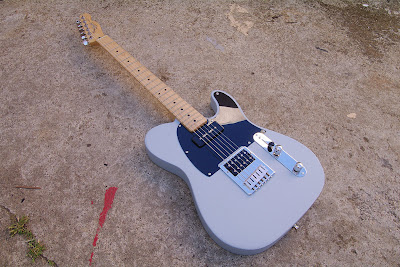The Telecaster is a great example of sonic perfection in its simplest form. Alder (or ash) slab body, maple neck, string-though body bridge with brass saddles, a hot single coil in the bridge and and even hotter one in the neck, 1 volume control, one tone control, and a three-position pickup selector. It is Leo Fender's first and quite possibly his finest mass produced electric guitar. It's dumbfoundingly simple and yet it produces some of the most recognizable tones in music. The Tele tone can be heard in classic recordings from The Clash, Radiohead, and The Rolling Stones. It is perfect. It is beautiful. It is precious. And so I'm going to take one and screw it up.
That's right I'm going to rip out the old bridge, gouge out the wood in the body and stuff in a humbucker like you would find in a Gibson. I'm going to carve up the pickguard and cram another Gibson pickup, a P-90, in the neck. And then I'm going to rip out it's guts and rewire the whole thing. Actually it's not as bad as it sounds, and much worse atrocities have occurred to Telecasters in the past. Don't worry, this particular Telecaster is made in a foreign country and cost me $200 in a pawn shop.
Here it is in stock form
I decided to do this project because of my curiosity for the P-90 pickup. I was listening to the Stone Temple Pilots album "Tiny Music... Songs From The Vatican Gift Shop," and I noticed how incredible Dean DeLeo's guitar sound was, I had to figure out what kind of guitar he was using. Actually he was probably using a bunch of different guitars, and the tone probably has a lot to do with the amp he was using, but in this video you can see that he's playing a Les Paul Jr. with P-90's. Anway, I figured the Telecaster, with its high sustain and bright tone, was a perfect starting point to try out this dark and raspy pickup. I needed something equally as fat to put in the bridge position so I opted for a hot humbucker to take the place of the single coil. This would of course require a whole new bridge and routing out the body to fit the larger pickup.
Putting a P-90 in the neck position is the easy part. In most Mexican and American Telecasters there is actually a rout in the body big enough for a humbucker or P-90, this is because many models are available with lots of different pickups, so they make just one body to suit many different models. Here you can see the black spring foam I put in the neck pocket, that is there to hold the P-90 at the correct height. The height adjustment screws go right down through the pickup into the wood in the body. This modification obviously wouldn't work with a "Dog Ear" P-90.
The pickup I'm installing is a Deep Blue pickup that I sell for $80. It uses Alnico V bar magnets, Nickel-plated steel pole pieces, and is scatter-wound with Formvar wire to 8.2k ohms of resistance.
Now for the tricky part. Obviously the old bridge is not going to be able to accomidate a humbucking pickup, so I bought a Gotoh Humbucker Bridge from Warmoth. This is a really nice piece with a 1/8" thick brass plate! I installed the bridge and used a sharpie to mark where I needed to rout.
For a really Clean rout I used a Humbucker Template from StewMac. Then I had to take off the template and carefully rout where the height adjustment screws would go, being careful not to go outside where the brass plate would cover.
Here is the guitar all put together. For routing the pickguard you can also use a StewMac template. A table router is really not a very expensive tool, I got mine used for $50 and you would be surprised at the repairs and modifications you can do with one. When you're ready to wire everything up check out the wiring diagrams at GuitarElectronics.com. The humbucker I used is one of my Deep Blue Alnico II Bridge humbuckers and it compliments the P-90 beautifully.
I was really surprised at how well the P-90 works in the Telecaster. Up until I did this project the best thing I had heard in a Tele was the USA Alnico pickups I had installed in it. The P-90 is bass heavy, but not in a flabby way, the bass tones stay punchy. And because it's scatter-wound the treble and harmonics come through nicely. It also has that trademark growl that make it unmistakeably p-90.
Shortly after this project I recorded some audio samples, you can listen to mp3 files here!







